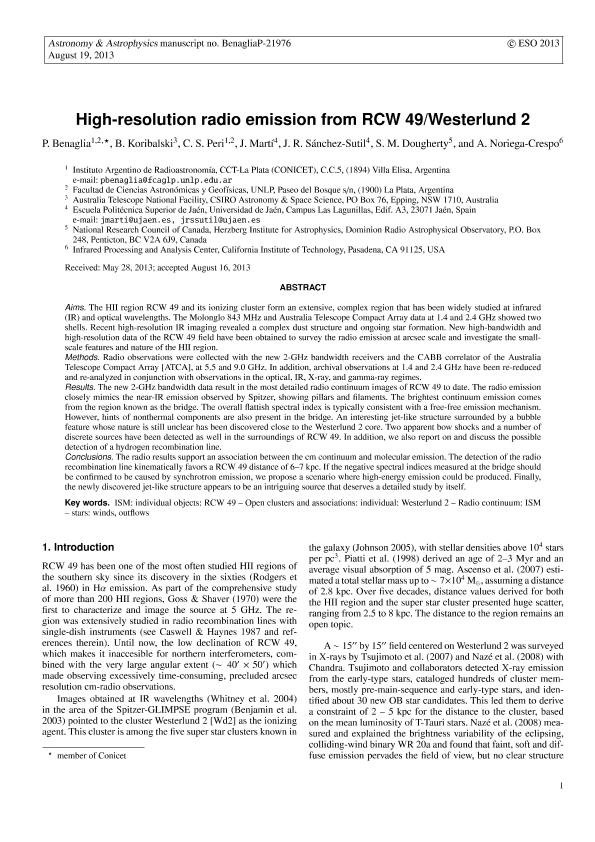Mostrar el registro sencillo del ítem
dc.contributor.author
Peri, Cintia Soledad

dc.contributor.author
Benaglia, Paula

dc.contributor.author
Koribalski, Bärbel Silvia
dc.contributor.author
Dougherty, Sean Melbourne
dc.contributor.author
Noriega-crespo, Alberto

dc.contributor.author
Sánchez Sutil, Juan R.

dc.contributor.author
Martí, Josep

dc.date.available
2015-12-22T17:37:10Z
dc.date.issued
2013-12
dc.identifier.citation
Peri, Cintia Soledad; Benaglia, Paula; Koribalski, Bärbel Silvia; Dougherty, Sean Melbourne; Noriega-crespo, Alberto; et al.; High-resolution radio emission from RCW 49/Westerlund 2; EDP Sciences; Astronomy and Astrophysics; 559; 12-2013; 31-39
dc.identifier.issn
0004-6361
dc.identifier.uri
http://hdl.handle.net/11336/3158
dc.description.abstract
Aims. The HII region RCW49 and its ionizing cluster form an extensive, complex region that has been widely studied at infrared (IR) and optical wavelengths. The Molonglo 843 MHz and Australia Telescope Compact Array data at 1.4 and 2.4 GHz showed two shells. Recent high-resolution IR imaging revealed a complex dust structure and ongoing star formation. New high-bandwidth and high-resolution data of the RCW 49 field have been obtained to survey the radio emission at arcsec scale and investigate the smallscale features and nature of the HII region. Methods. Radio observations were collected with the new 2-GHz bandwidth receivers and the CABB correlator of the Australia Telescope Compact Array [ATCA], at 5.5 and 9.0 GHz. In addition, archival observations at 1.4 and 2.4 GHz have been re-reduced and re-analyzed in conjunction with observations in the optical, IR, X-ray, and gamma-ray regimes. Results. The new 2-GHz bandwidth data result in the most detailed radio continuum images of RCW 49 to date. The radio emission closely mimics the near-IR emission observed by Spitzer, showing pillars and filaments. The brightest continuum emission comes from the region known as the bridge. The overall flattish spectral index is typically consistent with a free-free emission mechanism. However, hints of nonthermal components are also present in the bridge. An interesting jet-like structure surrounded by a bubble feature whose nature is still unclear has been discovered close to the Westerlund 2 core. Two apparent bow shocks and a number of discrete sources have been detected as well in the surroundings of RCW 49. In addition, we also report on and discuss the possible detection of a hydrogen recombination line. Conclusions. The radio results support an association between the cm continuum and molecular emission. The detection of the radio recombination line kinematically favors a RCW49 distance of 6-7 kpc. If the negative spectral indices measured at the bridge should be confirmed to be caused by synchrotron emission, we propose a scenario where high-energy emission could be produced. Finally, the newly discovered jet-like structure appears to be an intriguing source that deserves a detailed study by itself.
dc.format
application/pdf
dc.language.iso
eng
dc.publisher
EDP Sciences

dc.rights
info:eu-repo/semantics/openAccess
dc.rights
Atribución-NoComercial-CompartirIgual 2.5 Argentina (CC BY-NC-SA 2.5 AR)
dc.rights.uri
https://creativecommons.org/licenses/by-nc-sa/2.5/ar/
dc.subject
Medio Interestelar: Rcw49
dc.subject
Cumulos Abiertos y Asociaciones: Westerlund 2
dc.subject
Radiocontinuo: Mie
dc.subject
Estrellas: Vientos y Outflows
dc.subject.classification
Astronomía

dc.subject.classification
Ciencias Físicas

dc.subject.classification
CIENCIAS NATURALES Y EXACTAS

dc.title
High-resolution radio emission from RCW 49/Westerlund 2
dc.type
info:eu-repo/semantics/article
dc.type
info:ar-repo/semantics/artículo
dc.type
info:eu-repo/semantics/publishedVersion
dc.date.updated
2016-03-30 10:35:44.97925-03
dc.journal.volume
559
dc.journal.pagination
31-39
dc.journal.pais
Francia

dc.journal.ciudad
París
dc.description.fil
Fil: Peri, Cintia Soledad. Consejo Nacional de Investigaciones Científicas y Técnicas. Centro Científico Tecnológico - Conicet - la Plata. Instituto Argentino de Radioastronomia (i); Argentina
dc.description.fil
Fil: Benaglia, Paula. Consejo Nacional de Investigaciones Científicas y Técnicas. Centro Científico Tecnológico - Conicet - la Plata. Instituto Argentino de Radioastronomia (i); Argentina
dc.description.fil
Fil: Koribalski, Bärbel Silvia. Australia Telescope National Facility; Argentina
dc.description.fil
Fil: Dougherty, Sean Melbourne. Dominion Radio Astrophysical Observatory; Argentina
dc.description.fil
Fil: Noriega-crespo, Alberto. National Aeronautics And Space Administration; Estados Unidos
dc.description.fil
Fil: Sánchez Sutil, Juan R.. Universidad de Jaén; España
dc.description.fil
Fil: Martí, Josep. Universidad de Jaén; España
dc.journal.title
Astronomy and Astrophysics

dc.relation.alternativeid
info:eu-repo/semantics/altIdentifier/arxiv/http://arxiv.org/abs/1307.6473
dc.relation.alternativeid
info:eu-repo/semantics/altIdentifier/url/http://www.aanda.org/articles/aa/abs/2013/11/aa21976-13/aa21976-13.html
dc.relation.alternativeid
info:eu-repo/semantics/altIdentifier/doi/http://dx.doi.org/10.1051/0004-6361/201321976
Archivos asociados
